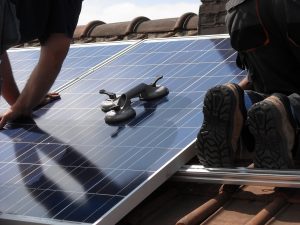 Save money on your increasing energy bills by generating your own clean electricity.
Save money on your increasing energy bills by generating your own clean electricity.
Solar electricity is free electricity from sun and environment friendly which will not leave the carbon foot print for the coming generation.
Help keeping the environment clean and green.
Thanks to rebates offered by the Federal Government under the RET scheme, solar panels are much more affordable for Australian homeowners, businesses and community groups.
Be rewarded with feed-in tariffs. If your solar system generates more power than you need, you have the potential to be reimbursed for any electricity your system feeds back into the grid, thanks to State Government feed-in tariffs (FITs). A feed-in tariff is a buy back rate paid on a net basis for any excess power your system produces that you don’t first use in your home. Feed-in tariffs are designed to encourage more Australians to generate their own electricity and vary by state.
There are three types of solar panels:
MONO-CRYSTALLINE SOLAR PANEL
As the name suggests mono-crystalline solar panels are made of single silicon. They are the oldest technology, and the most expensive to make, but they have the highest efficiency. These can get 12-17% efficiency in the real world. Mono-crystalline technology is the most tried and tested technology with minimal degradation of panel of 0.25-0.5% every year. These panels are used in the area without any shade and maximum exposure to sun.
MULTI-CRYSTALLINE SOLAR PANEL
These panels are also sliced from long cylinders of silicon, but the silicon used is multi-crystalline which is easier to make and also easier to install. They perform better in high temperature. They are very similar to single-crystalline in performance and degradation, except they are slightly less efficient, typically 11-14%. They are generally cheaper than mono-crystalline panels.
THIN FILM OR AMORPHOUS
Thin film solar panels are heavy and large as compare to mono-crystalline and multi-crystalline solar panels. Their efficiency is very less than mono-crystalline and multi-crystalline solar panels and they are generally cheaper than mono and multi-crystalline.
Many of the thin film amorphous solar products on the market today offer efficiency ratings that are quite inferior when compared to conventional mono and poly crystalline solar products. 6.3% for one of the more popular thin film amorphous a-Si solar panels that are being offered on today’s market versus 13 to 14 % for conventional crystalline silicon solar products. If this reduced efficiency was reflected in the true cost to the consumer, then thin film might be something worthwhile for residential applications.
INVERTER
Inverter is as important as solar panel because it converts the DC into AC. The electricity we use at home is AC (Alternative Current). There are few factors which you should consider before choosing an inverter.
- A transformer type or a transformer less type.
- A pure sine wave type (also called a sinusoidal type) or the modified sine wave type.
Transformers are quite heavy and are relatively expensive. Therefore, inverters with transformers are generally heavier and dearer than equivalent transformer less inverters. Transformers can also create a humming noise and this can be a problem if the inverter is near where people want quiet space. A good transformer less inverter will also probably be slightly more efficient that one with a transformer.
